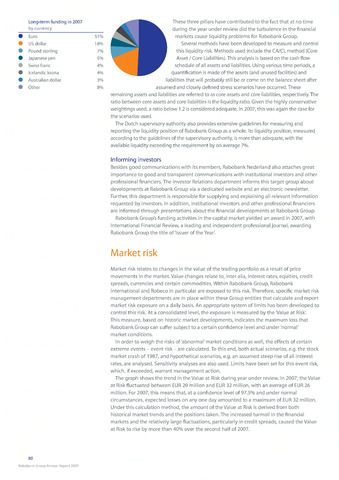Market risk
Informing investors
Long-term funding in 2007
by currency
Euro 51%
US dollar 18%
Pound sterling 7%
Japanese yen 5%
Swiss franc 4%
Icelandic krona 4%
Australian dollar 3%
Other 8%
These three pillars have contributed to the fact that at no time
during the year under review did the turbulence in the financial
markets cause liquidity problems for Rabobank Group.
Several methods have been developed to measure and control
this liquidity risk. Methods used include the CA/CL method (Core
Asset Core Liabilities). This analysis is based on the cash flow
schedule of all assets and liabilities. Using various time periods, a
quantification is made of the assets (and unused facilities) and
liabilities that will probably still be or come on the balance sheet after
assumed and closely defined stress scenarios have occurred. These
remaining assets and liabilities are referred to as core assets and core liabilities, respectively. The
ratio between core assets and core liabilities is the liquidity ratio. Given the highly conservative
weightings used, a ratio below 1.2 is considered adequate. In 2007, this was again the case for
the scenarios used.
The Dutch supervisory authority also provides extensive guidelines for measuring and
reporting the liquidity position of Rabobank Group as a whole. Its liquidity position, measured
according to the guidelines of the supervisory authority, is more than adequate, with the
available liquidity exceeding the requirement by on average 7%.
Besides good communications with its members, Rabobank Nederland also attaches great
importance to good and transparent communications with institutional investors and other
professional financiers. The Investor Relations department informs this target group about
developments at Rabobank Group via a dedicated website and an electronic newsletter.
Further, this department is responsible for supplying and explaining all relevant information
requested by investors. In addition, institutional investors and other professional financiers
are informed through presentations about the financial developments at Rabobank Group.
Rabobank Group's funding activities in the capital market yielded an award in 2007, with
International Financial Review, a leading and independent professional journal, awarding
Rabobank Group the title of 'Issuer of the Year'
Market risk relates to changes in the value of the trading portfolio as a result of price
movements in the market. Value changes relate to, inter alia, interest rates, equities, credit
spreads, currencies and certain commodities. Within Rabobank Group, Rabobank
International and Robeco in particular are exposed to this risk. Therefore, specific market risk
management departments are in place within these Group entities that calculate and report
market risk exposure on a daily basis. An appropriate system of limits has been developed to
control this risk. At a consolidated level, the exposure is measured by the 'Value at Risk'
This measure, based on historic market developments, indicates the maximum loss that
Rabobank Group can suffer subject to a certain confidence level and under 'normal'
market conditions.
In order to weigh the risks of 'abnormal' market conditions as well, the effects of certain
extreme events - event risk - are calculated. To this end, both actual scenarios, e.g. the stock
market crash of 1987, and hypothetical scenarios, e.g. an assumed steep rise of all interest
rates, are analysed. Sensitivity analyses are also used. Limits have been set for this event risk,
which, if exceeded, warrant management action.
The graph shows the trend in the Value at Risk during year under review. In 2007, the Value
at Risk fluctuated between EUR 20 million and EUR 32 million, with an average of EUR 26
million. For 2007, this means that, at a confidence level of 97.5% and under normal
circumstances, expected losses on any one day amounted to a maximum of EUR 32 million.
Under this calculation method, the amount of the Value at Risk is derived from both
historical market trends and the positions taken. The increased turmoil in the financial
markets and the relatively large fluctuations, particularly in credit spreads, caused the Value
at Risk to rise by more than 40% over the second half of 2007.
80
Rabobank Group Annual Report 2007

